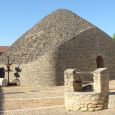Tomelloso
Advertisement
By road
There are two highways that connect Tomelloso, the CM-42 and A-43. It also has access to these roads: N-400, CM-400, CM-3102, CM-3103, CR-1225, CM-3109 .
Access to the downtown streets mainly by Don Victor Penasco, Mrs. Crisanta, Socuellamos Street and Field Street, belonging to the layout of roads CM-3103, CM-3109 and CR-1225 as it passes through Tomelloso.
By Bus
Tomelloso has a bus line with a ring-shaped path in the vicinity of the city. The ticket price in 2010 is 0.60 €. It also has a bus station with national and some international routes.
By Railway
Tomelloso rail does not have now, although it did have a passenger and freight station for over 40 years. The line was a branch Tomelloso-Cinco Casas, in the latter town, connected with the station Alcazar de San Juan, which, in turn, connected with the north (via Madrid ) and the south.
Tomelloso Town Hall
The town hall of Tomelloso was probably built in the late sixteenth century or early seventeenth century and responds to a type that was characteristic of these types of properties: the porch which remains today the most characteristic of building, along with the corridor that exists on it.On 18 December 1086, newly reconquered Toledo of Muslim rule, Alfonso VI donates the town of Brihuega the Archbishop of Toledo. From this date, the Archbishops of Toledo are Brihuega lords and their attached places, among which is Tomelloso. The state of vassalage Tomelloso regarding the Archbishops of Toledo is maintained until 1579, the year that Philip II, by a Brief of Pope Gregory XIII, is authorized to dismember the ecclesiastical powers of certain places and villas and add them to the Crown be sold to the proper places, that can then become a village by its own jurisdiction.
Church of the Assumption of Our Lady
Next to City Hall and the Inn of the portal is part of the emblematic buildings of the Plaza of Spain. Sixteenth century, with baroque reforms of the early seventeenth century. It has three naves and a dome, without drum.The old altarpiece in polychrome wood was burned during the Civil War 1936. The altarpiece is now 1940, polychromed wood and houses a statue of the Assumption
Posada de los Portales
Located in the Plaza of Spain, was built in the second half of the seventeenth century to shelter travelers and their horses, and this utility has continued until the 60's, when it was acquired by the City. The building retains its original structure with a portico on four Tuscan columns and two pillars. In the two-story wooden balcony. Also retains the original kitchen with a large bell-fireplace and many utensils also of the time.
Carriage Museum
It is located on the outskirts of the city, the road that goes to Pedro Munoz. It's a great building, very broad, adapted from inside and out to the needs of the museum and a Manchego style environment. It houses everything related to farm work, from cars and vehicles to tools and machinery. The enclosure is situated a typical construction of the region, the hype, large, made with all the traditional elements and following the proportions and distribution of authentic drums are standing still scattered throughout the fields of La Mancha.
Cuevas. House Painter and Francisco Mayor Carter
Tomelloso have in your basement drilled about 4,000 caves for wine storage, are vented to the outside by means of so-called louvers, grilles breathing are easily viewed on the sidewalks of the streets. Many of these caves retain the typical clay pots and other utensils for the preparation of wine .
Information not available





